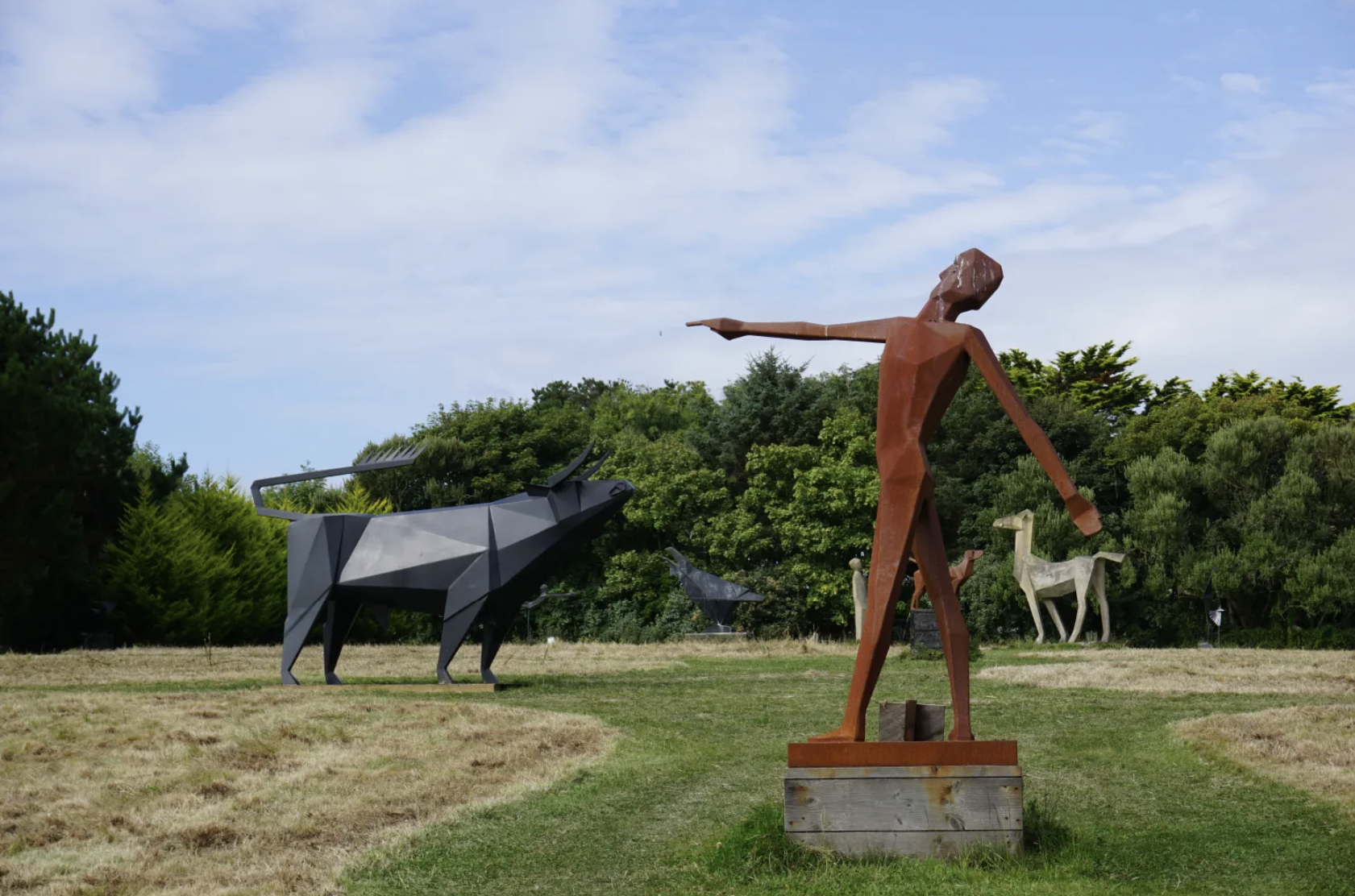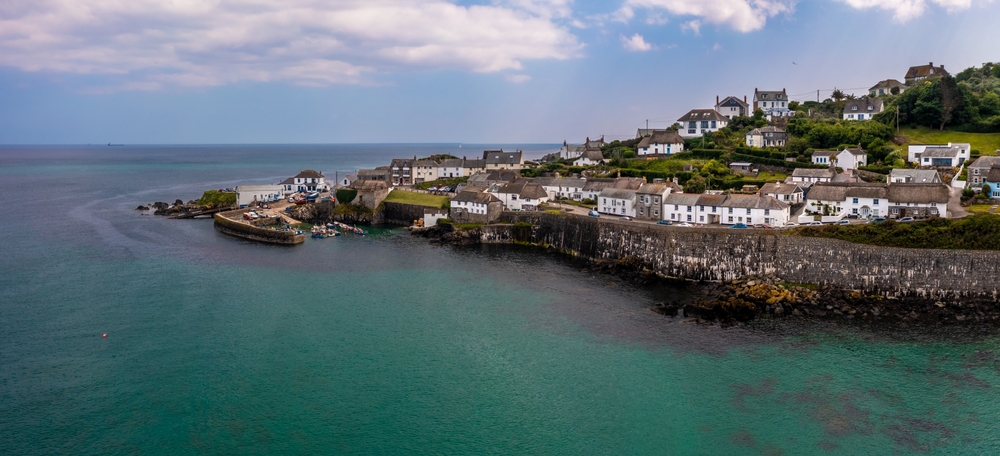Coverack Cove is a beautiful and historic coastal village tucked away on the southeast corner of the Lizard peninsula. This area of Cornwall remains relatively untouched by modern development and the hustle and bustle of modern life, making this pretty little fishing village the perfect place for a peaceful, seaside excursion.
With its picturesque ancient harbour, unusual geology and sandy beaches it is a great spot for sea swimming, ice cream eating, rock pooling, crabbing, windsurfing, diving and fishing.
Coverack was first recorded as a settlement in 1284 when it was known as ‘Porthkoverec’ which in Cornish means “landing place or cove with a stream”. It was once an infamous smuggler’s haunt and many of the thatched, white-washed cottages that line the curve of the coast still have secret caches in their floors where contraband was once hidden away.
Coverack Cove history
The smuggling might be a thing of the past but Coverack still has its own small fishing fleet that offers fishing trips and also supplies local restaurants with their catch. The Paris Hotel, Coverack’s only pub and one of the places to eat, was built in 1907 by Redruth Brewery and was named after the SS Paris, a liner that ran aground on rocks near Lowland Point, just to the east of the village.
The American Atlantic steamer came ashore in May 1899 due to a navigational error but fortunately all 400 passengers and crew were quicky brought to safety. The Paris became something of a tourist attraction as it remained perched on the rocks for several weeks. Local businesses popped up selling guided tours to go and view the wreck and the sightseers could even buy hastily printed postcards of the stranded ship. After seven weeks sitting on the rocks the Paris was eventually towed off and taken to Falmouth for repairs.
Coastal path
The stunning southwest coastal path passes through Coverack and offers amazing walking opportunities in either direction.
To the east the undulating path leads out to Lowland Point, a spike of low-lining land as the name suggests which is home to a number of prehistoric hut circles. From here the walker can also enjoy views out to the notorious Manacles reef that lurks beneath the waves just out to sea.
Coverack lifeboat
The Manacles were once considered a graveyard for ships and kept Coverack’s lifeboat men very busy. A great many lives have been lost to these rocks. The lifeboat station was built on Dolor Point, below the Paris Hotel, in 1901 following the wreck of the SS Mohegan on The Manacles in 1898 with the loss of more than 100 lives.
One of the greatest rescues that the Coverack Lifeboat was involved in happened in 1907. On 17 March the Suevic, sailing from Australia to Liverpool, ran aground against the rocks of the Maenheere Reef, a quarter of a mile off Lizard Point. Sixty volunteer lifeboatmen from Cadgwith, Coverack, The Lizard and Porthleven rowed back and forth from the ship in a violent gale for 16 hours to rescue all the passengers and crew.
Their incredible courage and perseverance saved 456 lives that day, and not a single life was lost. Subsequently six of the rescuers, including two Suevic crew members, were awarded Silver Medals by the RNLI in honour of their heroic actions.
The lifeboat station at Coverack eventually closed in 1978 and has since been converted into a Fish and Chip Restaurant with stunning views of the harbour and the sea.
Roskilly’s farm
A walk inland from Lowland Point brings you to Roskilly’s Farm, the home of what many believe is the best ice cream in Cornwall! This family-run business has been using the milk and cream from their own Jersey herd since 1950, to produce a delicious range of ice creams, sorbets and frozen yoghurts.
With more than 20 flavours to choose from there really is something for everyone. And a lot of locally sourced ingredients and a lot of love goes into every scoop! As well as the little café you can also meet the herd, visit the milking parlour which processes some 450,000 litres of milk each year and take woodland walks in the grounds.
Chynhalls Point
To the west of Coverack the coastal path leads to Chynhalls Point, a rocky headland crowned with the banks of an Iron Age Cliff Castle, and a little further on brings you to Black Head, another dramatic lookout point, from where the breathtaking views stretch to Lizard Lighthouse and beyond on a good day.
Terence Coventry Sculpture Park
A more inland path through fields takes you to the incredible Terence Coventry Sculpture Park. This free attraction was the brainchild of the artist Terence Coventry who lived on a farm just outside the village and filled a couple of meadows with his monumental work. The intrepid walker can discover the 25 impressive and unexpected sculptures of rooks, owls, swallows, bulls, cows, horses and dogs as well as people in a peaceful setting. This wonderful place is a real hidden gem and makes an ideal spot for a picnic.

Coverack geology
One of the most impressive things about Coverack however is its unique geology. The beach here is one of the few places in the world where the Earth’s crust and the mantle are exposed.
Much of the Lizard Peninsula is actually a slice of ancient ocean floor forced to the surface by unimaginable geological forces. Some 380 million years ago, the beach at Coverack sat in a molten layer around 5km beneath the Earth’s surface, sandwiched between the Earth’s crust and the mantle below it, a strange thing to ponder as you wander along the beach today or dip your toes in the water!
Whether you love walking, water sports, beaching or tickling your tastebuds, Coverack really does have so much to offer!
